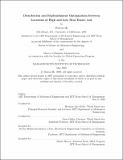Distribution and replenishment optimization between locations of high and low real estate cost
Author(s)
He, Denton(Denton Xiang)
Download1191623451-MIT.pdf (1.618Mb)
Other Contributors
Sloan School of Management.
Massachusetts Institute of Technology. Department of Mechanical Engineering.
Leaders for Global Operations Program.
Advisor
Hermano Igo Krebs and Jónas Oddur.
Terms of use
Metadata
Show full item recordAbstract
As companies expand and innovate, it is sometimes prudent to be conservative when incorporating new products and technologies. Instead of constructing buildings to store new products, firms may look to optimize re-allocation of space within existing facilities to fit more products and save on one-time capital outlay. In this research, the Distribution Center (which also picks and packs products according to incoming orders) is looking to optimize utilization of offsite storage (and transportation) costs in the face of growing product demand. The DC is situated in a region of High Real Estate cost, and there is potential to increase utilization of offsite leased storage at Low Real Estate cost areas. To investigate potential changes, research will be divided into two parts: Part One looks to optimize product storage within the current Distribution Center and Offsite Warehouse network, by developing a model that incorporates product demand, product sizes and replenishment frequency. Part Two utilizes the built model to investigate alternative offsite solutions, taking into consideration Real Estate costs, transportation frequency and other factors. Previous research papers have looked at the two parts separately, whilst this research aims to link the two parts together. Finally, a simple and easy to use decision-support tool was developed that allows users to periodically review and adjust product allocation based on product information, demand and Real Estate costs.
Description
Thesis: M.B.A., Massachusetts Institute of Technology, Sloan School of Management, in conjunction with the Leaders for Global Operations Program at MIT, May, 2020 Thesis: S.M., Massachusetts Institute of Technology, Department of Mechanical Engineering, in conjunction with the Leaders for Global Operations Program at MIT, May, 2020 Cataloged from the official PDF of thesis. Includes bibliographical references (pages 72-73).
Date issued
2020Department
Sloan School of Management; Massachusetts Institute of Technology. Department of Mechanical Engineering; Leaders for Global Operations ProgramPublisher
Massachusetts Institute of Technology
Keywords
Sloan School of Management., Mechanical Engineering., Leaders for Global Operations Program.